Please Remember
Please remember that the BIRDS AS ART blog is designed to be interactive. The more answers and comments that a post garners, the more you and I will learn. When there are few or no responses, I often ask myself, Why am I doing this?
Your Calls?
Which two of today’s eight featured images are your favorites? Why?
Which is the weakest image? Why?
Which two otherwise fabulous images feature less than ideal head angles?
I will share my thoughts on the above here soon.
Blessed at Indian Lake Estates
Unless it is sunny and cold with a northwest wind, I drive to the lake most mornings when I am home. Then I head back to Granada Drive for brunch at about 9:00am. Sometime near mid-morning, I get back to the lakeshore for my Vitamin D (no shirt) 1 1/2 mile walk. I get in a half-mile swim pretty much every day that I am home (15 days in a row, right now), and do my bursts most days as well. I have dinner no later than 4pm and then head down to the lake if the wind is right and there looks to be some chance of sunset color in the western sky. Understanding the wind and the sky conditions not only allows me to determine in advance the likelihood of success, but influences my choice of gear.
Today’s eight featured images were created at Indian Lake Estates during the last two weeks. As you view the images, consider the variety of subjects, the various lighting conditions, and the gear that I used to create the images. Thanks to Sony’s Zebra technology, all of the raw file exposures were either perfect or dead solid perfect. Ho hum.
Of course, if you are lucky enough to live in (or close to) a spot where the bird photography is pretty good, the following is always true:
1- The more time you spend in the field (even when conditions are poor or worse), the more you will learn.
2- The more time you spend in the field (even when conditions are poor or worse), the more great chances you will have.
3- When working with basically the same subjects most days, you will, by necessity, look for ways to create new and different images, to become more creative. A good part of that comes from exploring different perspectives.
4- When working with basically the same subjects most days, you will learn to use all of the lenses and teleconverters at your disposal.
At ILE, I know that Sandhill Crane, two species of vulture, and Cattle Egret can be easily photographed during most sessions. Boat-tailed Grackle, Savannah Sparrow, Killdeer, Double-crested Cormorant, Bald Eagle, Red-shouldered Hawk, Osprey, Great Egret, Anhinga, Limpkin, and right now, Crested Caracara, are present most days. The challenge is to create something different; capturing images that show birds in flight or in action, or bird behavior (including and especially courtship, other breeding behaviors, nesting, and raising young), always get me excited. And even at 30 fps, pretty much every frame is different. (In that vein, I can’t wait to get my hands on a Sony a-9 III (with the option to shoot at 120 fps!)
There are many species that I see occasionally but have never photographed or had a good chance on. Those include Palm Warbler, American Kestrel, Mourning Dove, Common Ground Dove, Belted Kingfisher, Common Moorhen, and Purple Gallinule. At my feeders, there are White-winged Dove, Chipping Sparrow, Northern Cardinal, Red-bellied Woodpecker, Bobwhite, and rarely Yellow-throated Warbler and Painted Bunting.
When a new species shows up to have its photo taken, I get really excited. Can you say Sharp-shinned Hawk? Over the years, I have tried and failed more than a few times to make a decent image of Northern Harrier. Also in that category is breeding plumage Glossy Ibis. I had one superb chance on that species several years ago in May. I had the shot in focus in the viewfinder. But I waited for something more perfect and wound up with nothing.
The highlights have been many — a Whooping Crane when I first moved to ILE, strutting tom Wild Turkeys, the banner Osprey spring of 2021 with two or three chicks fledging in each of eight nests, the Bald Eagle nest two seasons running, the low-water-level spring Black-necked Stilt nests, and the 2020 Mother’s Day crane nest with chicks!
So yes, I am extremely blessed to be able to get out most days with a reasonable chance of creating a Family Jewel or two.
What’s Up?
Today is Tuesday 12 December 2023. Wherever you are and whatever you are doing, I hope that you too have a great day.
Well, with a sunny morning with a NW wind predicted, my plan was to finish this blog post, have my brunch, and answer lots of e-mails. But when I walked out onto the pool deck to check the weather, there was a large cloud in the eastern sky so I drove down to the lake. Here is what I saw: more than 100 Turkey Vultures, 30 cormorants, more than 20 Killdeer, two small shorebirds, most likely Least Sandpipers, three Forster’s Terns, a Ring-billed Gull, at least two dozen Black Vultures, many dozens of Boat-tailed Grackles, six Cattle Egret, three White Ibis, several Mourning and Common Ground Doves, 100 Tree Swallows, three Osprey, one Pied-billed Grebe, about a dozen American Kestrel, and the caracara pair foraging in someone’s front yard.
I am pretty sure that I did not create anything really special but I learned a lot and brain-catalogued some info that might pay off in the future.
|
|
|
This image was created on 29 November 2023 down by the lake near my home. I used the handheld Sony FE 200-600mm f/5.6-6.3 G OSS lens (at 600mm) and The One, the Sony Alpha 1 Mirrorless digital camera. ) The exposure was determined via Zebras with Exposure Compensation on the Thumb Dial. Multi-metering +2 stops in Shutter Priority mode. AUTO ISO set ISO 2000: 1/2500 sec. at f/6.3 (wide open). AWB at 5:24:24pm minutes before sunset. Tracking: Zone/AF-C with Bird Face/Eye Detection performed perfectly. Be sure to click on the image to enjoy a high-res version. Image #1: Turkey Vulture in flight/sunset silhouette
|
Right Place, Right Time
The wading bird winter roost at the North Field is no longer. And I have not had a bird on The Perch at sunset in many months. My new spot is a short dirt road that leads out to the lake at the south end of the South Peninsula. With some sky color and a bit of luck, it can be productive as there is a big vulture roost right across the canal. The 200-600 allows you to move quickly into place as compared to working with the 600mm f/4 on a tripod (with either TC).
|
|
|
This image was also created on 2 December 2023 at Indian Lake Estates, FL. Standing at full height down by a canal, I used the Robus RC-5558 Vantage Series 3 Carbon Fiber Tripod/Levered-Clamp FlexShooter Pro-mounted Sony FE 600mm f/4 GM OSS lens and The One, the Sony Alpha 1 Mirrorless digital camera. The exposure was determined via Zebras with ISO on the Thumb Dial. ISO 1250: 1/4000 sec. at f/4 (wide open). AWB at 9:12:32am on a sunny morning. Tracking: Zone/AF-C was active at the moment of exposure and performed perfectly. Be sure to click on the image to enjoy the larger version. Image #2: Black Vulture on ground with wings raised |
Road-kill Cafe
I have been putting out road kill for the vultures for several years often with great success. More recently I have been putting out rotten, smelly fish, the rottener and the smellier, the better. By setting up along the edge of a canal I am pretty much at eye level with the birds. I replaced the head on this bird with the sharp head from the next frame.
|
|
|
This image was also created on 2 December 2023 near the boat ramp at Indian Lake Estates. While standing at full height, I used the handheld Sony FE 70-200mm f/2.8 GM OSS II lens with the Sony FE 2x teleconverter (at 388mm), and The One, the Sony Alpha 1 Mirrorless Digital Camera.. The exposure was determined via Zebras with ISO on the Thumb Dial. ISO 1250: 1/2000 sec. at f/5.6 (wide open). AWB at 12:20:43pm on a sunny afternoon. Tracking: Expand Spot/AF-C performed perfectly. Click on the image to enjoy a high-res version. Image #3: Spatterdock seed capsule |
Spatterdock Seed Capsule
The base of knowledge of the combined BAA blog audience is astounding. Thanks to Larry Master for sending me a link that enabled me to properly identify the seed capsule of this common aquatic plant, Yellow Pond Lily, AKA Spatterdock. The actual flowers are round and yellow. Click here to learn more about Yellow Pond Lily (Nuphar luteum).
The bare Sony 70-200 II is an amazingly versatile lens. Adding either teleconverter increases the usefulness of the lens exponentially. Imagine a small, lightweight rig, the 70-200/2X TC/a-1 combo, that is great for birds in flight, great for tight head shots of tame birds, great for photographing bird behavior, and can also be used for medium-sized and large flowers (or seed capsules). The Spatterdock seed capsule above is less than one inch in diameter.
|
|
|
This image was created on 2 December 2023 near the pier at Indian Lake Estates. While standing at full height, I used the handheld Sony FE 70-200mm f/2.8 GM OSS II lens with the Sony FE 2x teleconverter (at 400mm), and The One, the Sony Alpha 1 Mirrorless Digital Camera.. The exposure was determined via Zebras with ISO on the Thumb Dial. ISO 1600: 1/2500 sec. at f/5.6 (wide open). AWB at 12:30:20pm on a then cloudy afternoon. Tracking: Zone/AF-C performed perfectly. Click on the image to enjoy a high-res version. Image #4: Sandhill Crane with dried grasses in bill |
Loving the Peashooter Rig on Cloudy Day Walks
As noted here previously, I recently began taking my Vitamin D (no shirt) walks with the Sony 70-200 f/2.8 II/2X TC/a-1 rig in hand. It is light and amazingly versatile. The powers that be at ILE recently spent at least a few thousand bucks to construct a small beach just left of the pier. So far, no human has made use of the new “recreational area.” The birds — mostly cranes, vultures, and Killdeer, however, spend lots of time there. And the sand makes a nice background.
The cranes have been courting for about a month now. Grabbing a mouth full of dried grasses and then tossing the grass up in the air is part of their ritual.
When this happens, the pair will begin to dance, jumping into the air and flapping, all toward the end of cementing the pair bond.
|
|
|
This image was created on 3 December 2023 on the pier at Indian Lake Estates. While standing at full height, I used the handheld Sony FE 70-200mm f/2.8 GM OSS II lens with the Sony FE 2x teleconverter (zoomed out to 294mm), and The One, the Sony Alpha 1 Mirrorless Digital Camera.. The exposure was determined via Zebras with Exposure Compensation on the Thumb Dial. Multi-metering +2.3 stops in Shutter Priority mode. AUTO ISO set ISO 12800: 1/3200 sec. at f/5.6 (wide open). AWB at 9:11:02am on a cloudy morning. Tracking: Zone/AF-C with Bird-Eye/Face Detection performed perfectly. Click on the image to enjoy a high-res version. Image #5: Boat-tailed Grackle — dorsal view of male in flight |
High ISO, Dorsal View, Spread Tail Flight
It would be hard to imagine a more dynamic flight pose. Working in Shutter Priority with Exposure Compensation (EC) on the Thumb Dial and AUTO ISO, enables me to point and shoot, having only to adjust the EC. It does take some experience to get close on the exposures. The small size and light weight of the peashooter rig is a godsend when you are attempting to photograph small, fast songbirds in flight.
|
|
|
This image was created on 8 December 2023. Seated in my SUV, I used the BLUBB-mounted Sony FE 600mm f/4 GM OSS lens with the Sony FE 1.4x Teleconverter, and The One, the Sony Alpha 1 Mirrorless Digital Camera.. ISO 1000: 1/800 second at f/5.6 (wide open) in Manual mode. AWB at 7:56:16am on a partly cloudy morning. Tracking Expand Spot/AF-C performed perfectly. Be sure to click on the image to enjoy a larger, sharper, high-res version. Image #6: Cooper’s Hawk on The PerchThanks to Ryan Sanderson for suggesting that my original ID — Sharp-shinned Hawk, was incorrect. |
First-Ever
As I mentioned last week, I had my first-ever Sharp-shinned Hawk on The Perch, the perch that I erected several years ago with the help of my ILE-neighbor, Ralph. Long story’s short, I realized after I began my approach that I had “only” the 1.4X TC on the lens and that the 2X TC was in the rear hatch. Nonetheless, I was happy with the result and loved the right-down-the-lens barrel stare showing both eyes. And the superb a-1 image quality allowed for about a 50% crop.
|
|
|
This image was also created on 9 December 2023 at Indian Lake Estates, FL. Standing at full height down by a canal, I used the Robus RC-5558 Vantage Series 3 Carbon Fiber Tripod/Levered-Clamp FlexShooter Pro-mounted Sony FE 600mm f/4 GM OSS lens and The One, the Sony Alpha 1 Mirrorless digital camera. The exposure was determined via Zebras with ISO on the Thumb Dial. ISO 640: 1/4000 sec. at f/4 (wide open). AWB at 8:54:24am on a sunny morning. Tracking: Zone/AF-C was active at the moment of exposure and performed perfectly. Be sure to click on the image to enjoy the larger version. Image #7: Sandhill Crane gaining altitude just after taking flight |
Accidental Crane
I was surprised when a pair of cranes walked up to the thirty or so Black Vultures feeding on a rotten Black Drum carcass. I missed several interactions as the cranes gave the vultures “what for.” Then I missed the first crane taking off, but was ready for the second one. Though the vanes of the vulture feathers and the legs have some bright highlights, the adult crane’s white cheek patch is brighter still; thus, I reduced the ISO by 1 click, 1/3-stop an round up with another perfect exposure.
|
|
|
This image was created on 10 December 2023. Seated in my SUV, I used the handheld(!) Sony FE 600mm f/4 GM OSS lens with the Sony FE 1.4x Teleconverter, and The One, the Sony Alpha 1 Mirrorless Digital Camera.. ISO 1250: 1/2000 second at f/5.6 (wide open) in Manual mode. AWB at 7:58:24am on a variably cloudy morning. Tracking: Zone/AF-C performed perfectly. Be sure to click on the image to enjoy a larger, sharper, high-res version. Image #8: Crested Caracara taking flight |
Handheld at 840mm
With the pair of caracaras on the ground, I was working with the 600 and the 1.4X TC off the BLUBB. When I saw several Black Vultures flying in to grab the fish skin that the caracaras were ripping up, I anticipated that they would take flight into the southeast wind. As I was fairly close to the birds and it is difficult for me to handhold the 600 for more than a few moments, I clipped wings in all but three images in the 15-frame sequence. One, however, is all it takes 🙂
|
|
The BAA Middle of Florida Photographic Site GuideYou can purchase your copy here in the BAA Online Store. |
The BAA Middle of Florida Photographic Site Guide
126 pages, 87 photographs by Joe Przybyla and Arthur Morris.
The PDF for this e-Guide is an electronic download sent via e-mail.
Purchase your copy here in the BAA Online Store.
I had thought about doing a guide to some of the great but little-known photo hotspots around central Florida for about a decade, but those plans never came to fruition. I met Joe online in the Avian Forum at BirdPhotographer’s.Net about two years ago. Joe’s photography has improved tremendously over the past few years; he credits the BAA blog, my books and PDFs, and his participation on BPN. The one thing that I learned right from the get-go about Joe is that he is a hard and tenacious worker, always striving to improve his skills and to grow his knowledge base. As he knew of more than a few good spots in central Florida, I broached the idea of us doing a photographic site guide that covered many of the little-known photographic hotspots from Brandon to Lakeland to Joe Overstreet Road to Indian Lake Estates (my Florida home for the past 20 years or so). After more than many, many dozens of hours of effort, The BIRDS AS ART Middle of Florida Photographic Site Guide is now a reality. Thanks to Joe’s wife Dottie for her review of our writing. We all learned once again that writing is a process, a back-and-forth process. All thanks to the white pelicans of Lakeland. Below are the locations that are detailed in this e-Guide. Please note that last season, Gatorland did not offer a Photographer’s Pass.
- Indian Lake Estates: Sandhills Cranes with chicks and colts, lots of vultures, and Ospreys up the kazoo!
- Gatorland, Kissimmee: Learn to make great images of wading birds in a cluttered rookery.
- The Brandon Rookery: Great for nesting Wood Storks, Great Egrets, and more.
- Circle Bar B Reserve, Lakeland: Here you will find a great variety of avian subjects in a great variety of habitats.
- Lake Morton, Lakeland: There are lots of silly tame birds here including and especially American White Pelican during the colder months.
- Lake Mirror, Lakeland: Tame Anhingas, Limpkins, and a zillion White Ibises at times.
- West Lake Parker, Lakeland: Here, if you are lucky, you will have a chance for two difficult birds: Snail Kite, and Purple Gallinule.
- Joe Overstreet Road, Kenansville: Crested Caracara, meadowlarks, Loggerhead Shrike, and much more on the fenceposts and barbed wire.
Each location includes a map, a detailed description of the best spots, best season, light and time of day instructions, the expected species, and an educational and inspirational gallery that is designed to open your eyes as to the possibilities.
You can purchase a copy here in the BAA Online Store.
Typos
With all blog posts, feel free to e-mail or to leave a comment regarding any typos or errors.

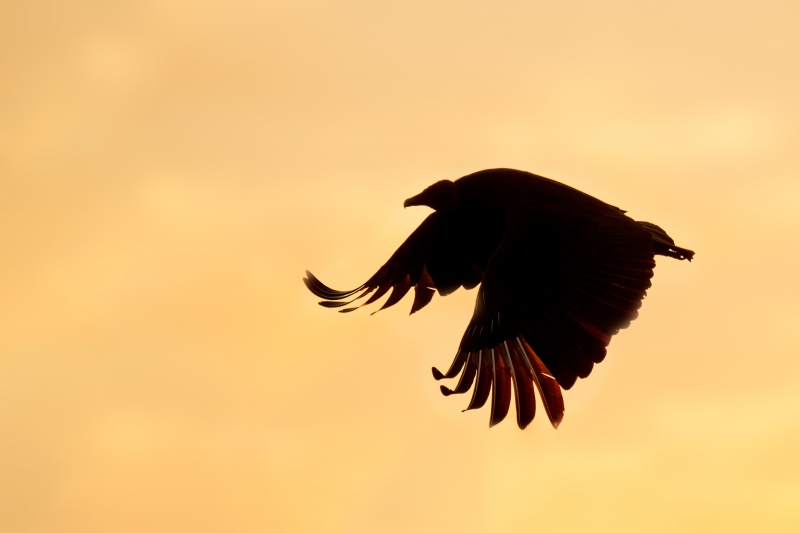
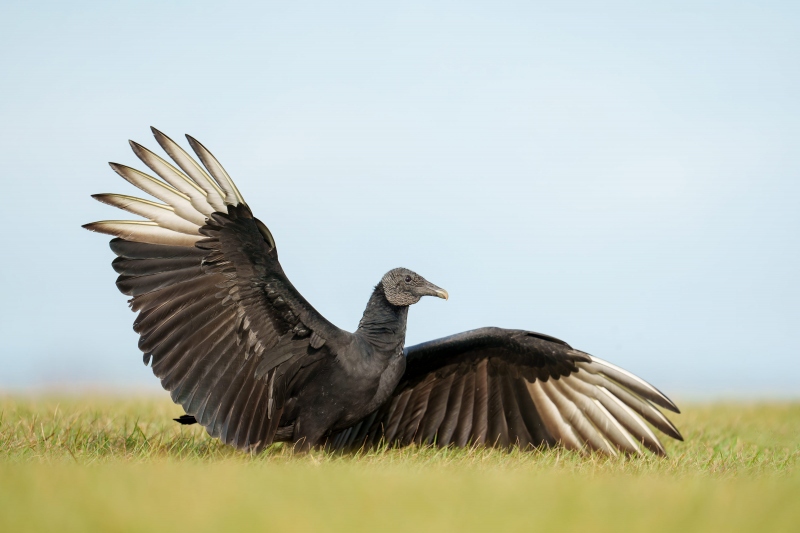
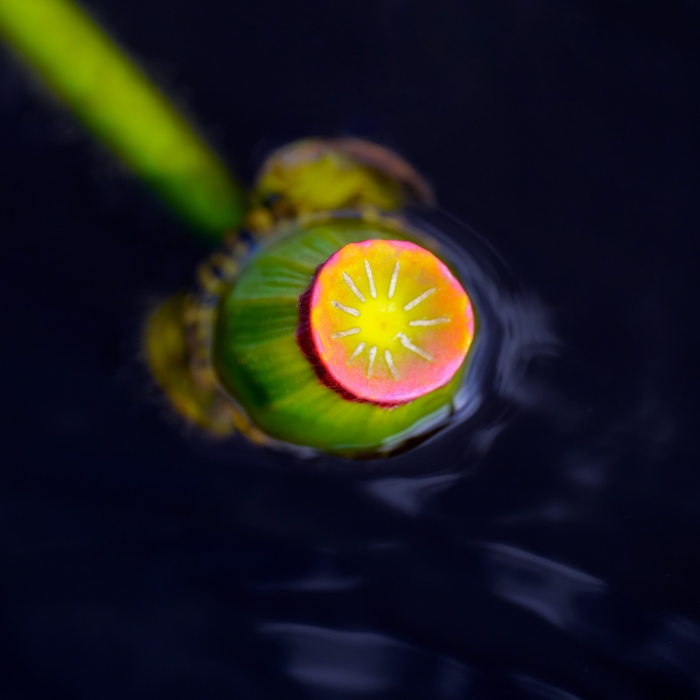
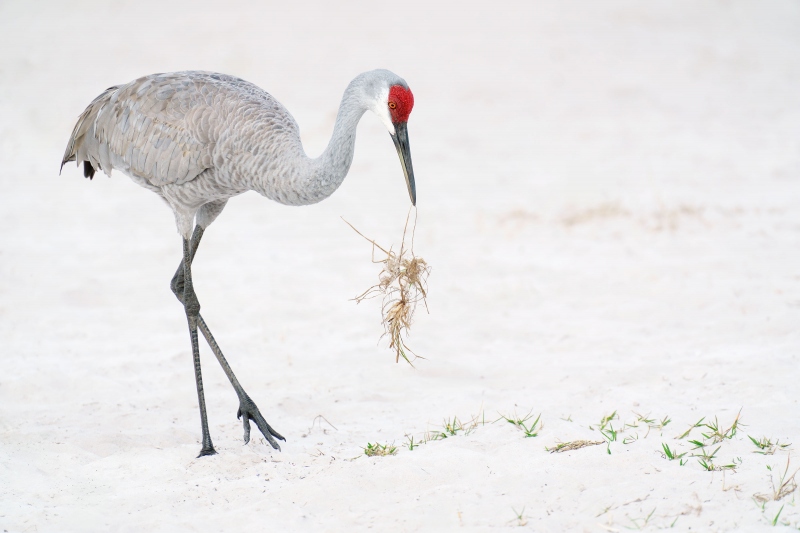
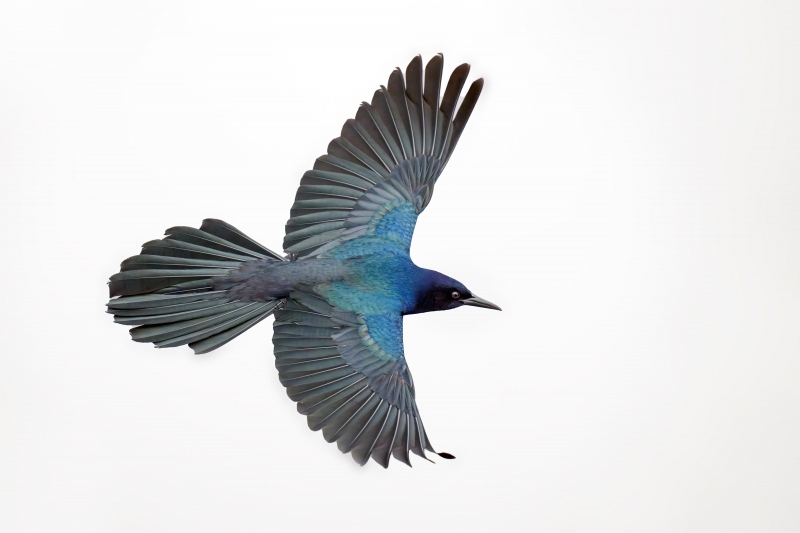
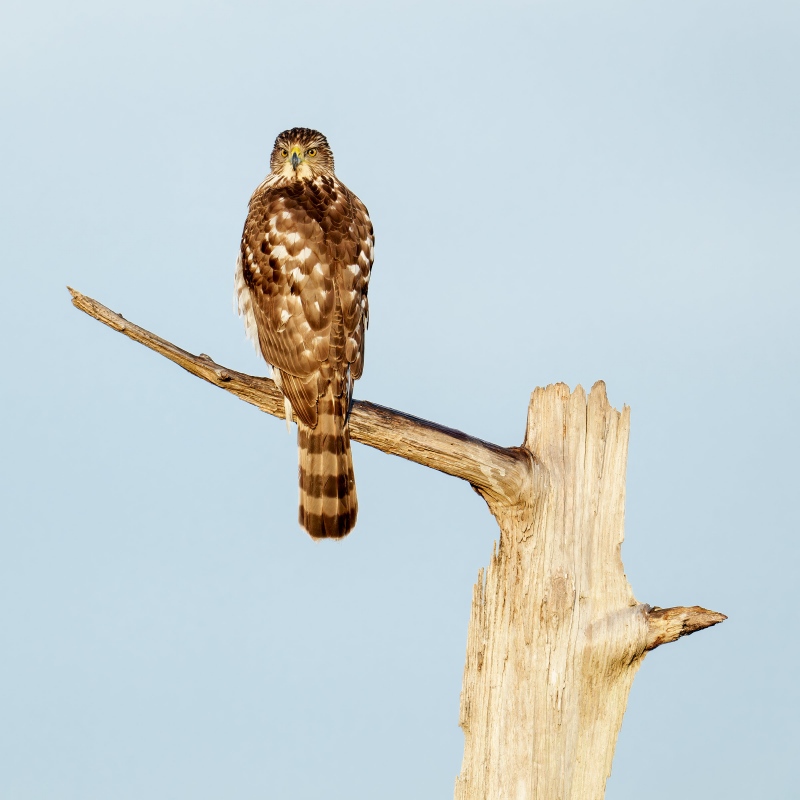
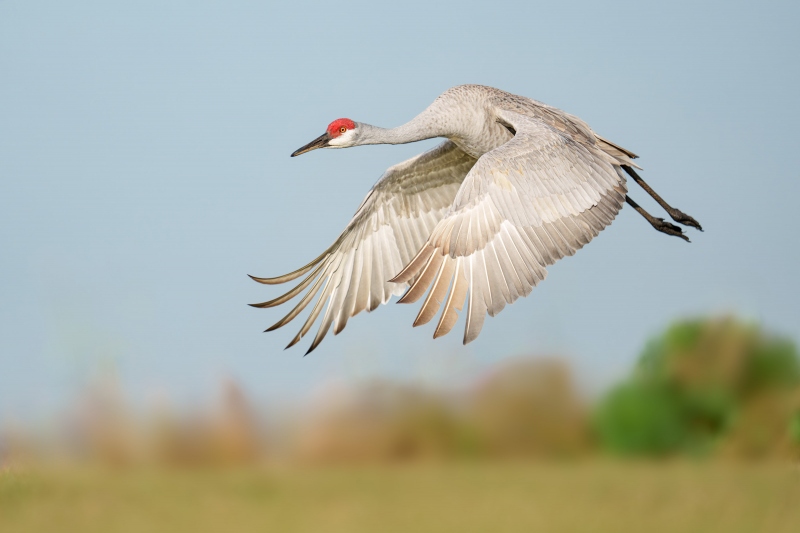
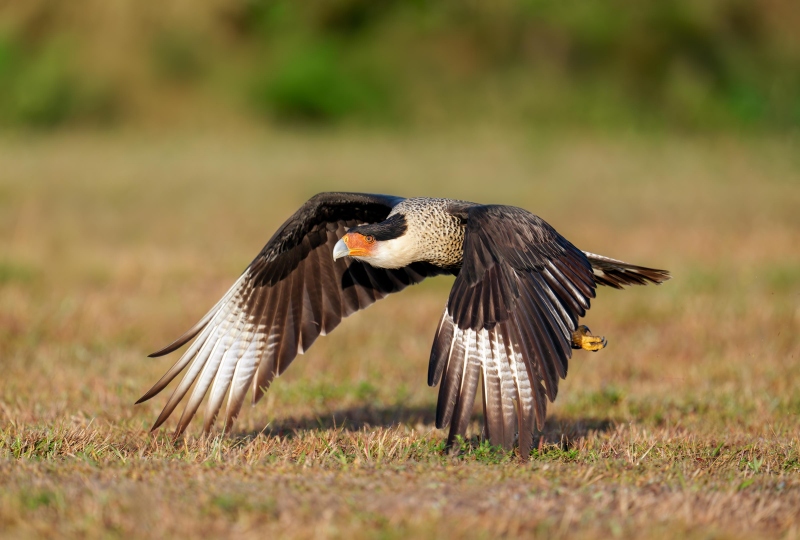
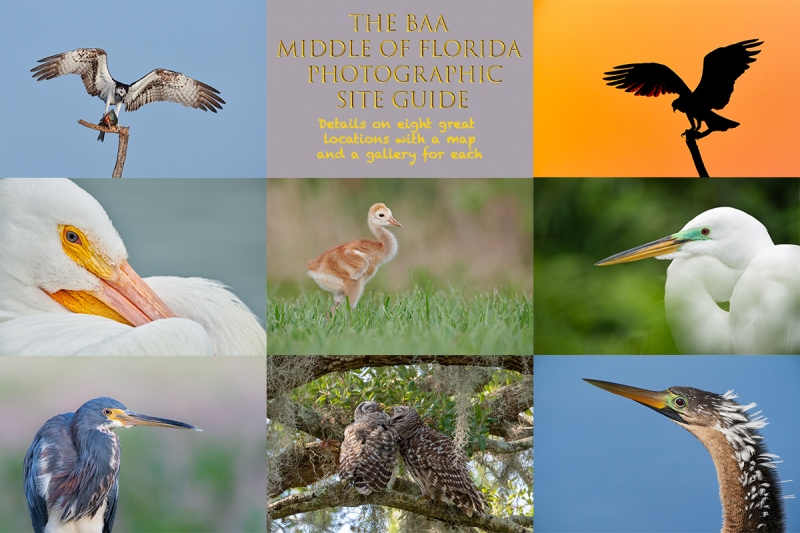













Hi Artie – I like them all, with the Boat-tailed Grackle being my favorite (a stunning photo, not easy to get in that pose) followed by the Sandhill Cranes and the Crested Caracara. If you had just shot the grackle in manual mode do you think you would not have been successful i getting that shot?
Accipiters, in my opinion, are notoriously hard to identify when perched with their back to you and legs and feet (relatively thick on a Cooper’s) not visible. I agree with Ryan that the tail shape seems more like a Cooper’s, and the body shape (widest portion of chest halfway down the body vs. widest at the shoulder), relatively long tail, eyes appearing to be close to the front of the head (vs. halfway), and seemingly large head also point to Cooper’s. I am slightly disturbed (re ID as a Cooper’s) by the glimpse of the flanks (not narrow dark streaks as on an immature Cooper’s) and narrow white at the end of the tail (although the latter gets worn down). But overall I think it’s a Cooper’s, but many people are much more expert than me at accipiter ID.
Thanks, Larry. Which crane image? (There are two).
If I knew the exposure beforehand I could have made the same photo. But that is pretty much impossible when you are facing a variety of situations. When that is the case, Shutter Priority with AUTO ISO can save the day in the right hands. You’ve got to have a good idea on the needed EC (exposure compensation) and you need to have an easy way to change the EC. That dial on the a-1 is worthless; you need to assign EC to someplace else.
Everyone that I contacted agrees 100% with Ryan. The bird is a Cooper’s Hawk. My bad. That was my assumption until I talked my way out of it. The few coops I have seen always look somewhat blocky/square headed.
with love, a
Hi, Artie. Image #5 is my favorite. The spread-out wings and tail with the shimmering blue colors on the back of the grackle against the high key background is just perfect. For my second favorite image, I’m torn between #7 and #8. The pose of the sandhill crane in flight is astounding but the caracara image is very unique and difficult to capture. If the caracara was 2-3 inches higher so that the wings were fully extended while the tips of the feathers were still touching the ground, I think, that would’ve made that image a 110%.
Hey Don, Thanks for your thoughtful comments and welcome here 🙂
Where have you been?
much love and stay tuned,
artie
Hi Artie, I too like #5 and #8. #5 boat tailed grackle for the High Key background, wonderful blues on the bird and it reminds me of Audubon paintings. Though you may not be thrilled with the head angle of the bird. The crested caracara with the wings brushing the ground and the super sharp head is excellent. Love it. The other head angle that may be suspect is the Black Vulture in #2.
All my best,
Joe
Thanks, Joe. First perfect answer on the head angles. And to think that I replaced the head of the BV in #2!
with love, artie
What made you decide the hawk was a Sharp-shinned as opposed to a Cooper’s Hawk? It looks like an immature Cooper’s Hawk to me, the biggest point for that to my eye is the rather bulbous head in contrast to what is usually a pretty petite head on a Sharp-shinned Hawk. Also, the outer tail feathers appear to be notably shorter than the more central tail feathers, and those are usually roughly the same length on Sharp-shinned Hawks.
Thanks, Ryan. You may be correct. When I saw the long tail, I assumed Cooper’s. In the other images that I kept, the bird does not show the square-headed look and appears quite slim. I will consult others more knowledgeable than me and let you know.
with love, artie
I like the boat tailed crackle, enjoy seeing them all. Some blogs may garner less responses for any number of reasons. Some just might not be as up to par(excellence) we’ve come to take for granted. Maybe some were rushed, less informative, not as brilliantly artistic as others and so on. But, please rest assured I may not always comment but I always peruse and read and take a good gander at your photos. Hopefully learning and gleaning from one of the very best. Please rest your mind. We care my pen pal friend and teacher.
Much love, Jeff
🙂 Perhaps, or perhaps many simply take the blog for granted 🙂
with love, artie
ps: grackle, not crackle !
Three favorites (rules are meant to be broken, no?) are #4 Sandhill (action and unusual habitat, even for a bird with “sand” in the name), #5 Grackle (beautiful studio-like image with great color and position), and #7 Sandhill (haven’t seen many Florida Sandhill flight photos). Wouldn’t say #3, the spatterdock, is weak (love the color), though I’d personally like more ISO and DOF. None of the head angles bother me (even in #1–it fits the action).
Thanks as always, Cliff. There actually are sandhills on the Lake Wales Ridge but the cranes do not hang out there. I too love the spatterdock seed capsule for the colors; not easy to go for more d-o-f from a floating dock on a windy day 🙂
#1 is one of them …
with love, arite
Hi Artie,
Which two of today’s eight featured images are your favorites? Why?
– Sandhill Crane
– Crested Caracara
– Both birds are well positioned within the frame. Heads/eyes are well positioned. Both have nice, smooth backgrounds. I also like the Sandhill Crane but think it would be a better shot if the legs were not crossed.
Which is the weakest image? Why?
Boat-tailed Grackle. No background. Bad angle.
Turkey vulture is a butt shot flying away but the background is gorgeous.
Which two otherwise fabulous images feature less-than-ideal head angles?
– Boat-tailed Grackle
– Turkey Vulture
Thanks, Jordan,
Which crane image? There are two?
Different strokes. Several folks picked the grackle as their favorite.
The TV is flying slightly away and that is a negative.
Good on one of the head angles.
with love, artie
Sorry – allow me to be more clear.
Sandhill Crane in Flight and the Crested Caracara are my two favorites.
I also like the standing Sandhill Crane but I think it would be stronger if the legs did not merge.
J
Thanks. We surely see things differently — the raised foot of the crane on the sand is a huge plus in my eyes.
a
Boat tailed grackle is my first choice. The in flight shot shows colors I did not know they had, very sharp, well captured.
Second is the caracara, the low flight image is quite interesting.
Welcome, John!
I too love the dorsal view of the grackle.
with love, a
Artie
I don’t really like any of them, sorry!
I love em 🙂 🙂
And you wonder why you do the blog and see very few if any comments at time, Artie you love doing this it is in your passion in your soul and i know it after rooming with you for 3 weeks you live and breathe photography!
Oh ok picking 1 it would have to be #7 great head angle and nicely above the distant background and both feet separated nice and just really pleasing over all followed by #3 being creative.
Always with love b
PS #1 is to dark……lol 🙂
Image Nr. 2 would have been out of this planet of you would have been able to photograph it from a low angle
Confused. I was right at the bird’s eye level.
with love, artie
Images #2 and #4 and #5 and #6 and #7 and #8 are interesting! Image #1 Turkey Vulture and Image #3 are too dark to see them well.
Hi, Artie. My two favorites are #5, boat tailed grackle, and #8, crested caracara. Both images have birds with great wing position, color, and pose, and have great composition. The caracara’s head angle is perfect; the grackle’s head angle is fine. I love the blue in the grackle. I also like #6, the sharpie. I don’t like picking “worst” or “weakest” images so I’ll just say that images 5, 6, and 8 stood out above the others for me.
Many thanks, Dr. Fish.
with love, artie